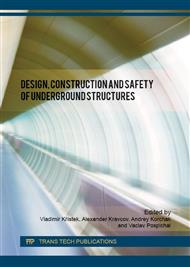[1]
I.V. Baklashev, B.A. Kartozia, Underground Structures Mechanics and Lining Designs, textbook, 2nd edition, Moscow, Student Publishers, (2012) 513p. (in Russian).
Google Scholar
[2]
B.A. Kartozia, On Some Scientific, Industrial and Educational Issues of Construction Geotechnology in the Light of Underground Space Development, GIAB, 2010, fascicule No. 6, Gornaya Kniga. (2010) pp.11-34 (in Russian).
Google Scholar
[3]
J-L. Briaud, Geotechnical Engineering: Unsaturated and Saturated Soils. Wiley & Sons, 2013, , (2013) 1020 p.
Google Scholar
[4]
B.A. Lysikov, L.L. Kaufman, Underground Structures (in 2 parts) Part I, Nord-Press, (2005) 280p. (in Russian).
Google Scholar
[5]
A.V. Korchak, V.A. Pshenichny, A.V. Oborin, New Methods to Enhance the Stability of Large-Span Underground Structures, Proceedings of the VI International Geomechanics Conference. Varna, Bulgaria, (2014) p.203–209.
Google Scholar
[6]
A.V. Oborin, Construction of Large Span Structures in Complex Geomechanical Environments, Collected Articles of Students of the RPM Faculty on Mining, Industrial Safety, Ecology, Economics, Management, Moscow, MGGU, (2011) pp.21-25 (in Russian).
Google Scholar
[7]
I.V. Kachan, V.A. Pshenichny, Peculiarities of formation of plastic range of stress in underground openings driven by the drill and blast method and continuous mining machines, Geomekhanicheskiye problemy vysokoproizvoditelnoi razrabotki tonkikh i srednei moshchnosti ugolnykh plastov na glubokikh gorizontakh [Geomechanical Problems of Highly Productive Mining of Deep-Seated Thin and Medium Coal Beds], Donetsk, (1980).
Google Scholar
[8]
H. Engel, Tragsysteme/Structure Systems, Hatje Cantz Publisher, 3rd Edition, (2007) 344p.
Google Scholar
[9]
SP 91. 13330. Underground Mine Workings, Moscow FAU «FTsS», (2012) 56p. (in Russian).
Google Scholar
[10]
A.A. Shilin, V.A. Pshenichny, D.V. Kartuzov, Strengthening of Reinforced Concrete Structures with Composite Materials. Moscow, Sroiizdat, (2007) 181 p. (in Russian).
Google Scholar
[11]
N. Fardis Michael, Innovative Materials and Techniques in Concrete Construction. Springer, (2014) 396 p.
Google Scholar
[12]
S.A. Bokarev, G.M. Vlasov, A.A. Herovnykh, D.N. Smerdov, Reliability Coefficients of Composite Materials Used to Strengthen reinforced concrete elements of Bridge Structures., Vestnik TGASU [Bulletin of Tomsk State University of Architecture and Building], No. 2, (2012, ) p.222.
Google Scholar
[13]
Y.Y. Wei, Y.F. Wu, Unified stress-strain model of concrete for FRP-confined columns. In: Construction and Buildings Materials. 26, (2012) p.381 – 392.
DOI: 10.1016/j.conbuildmat.2011.06.037
Google Scholar
[14]
M.N.S. Hadi, I.B.R. Widiarsa, Axial and Flexural Performance of Square RC Columns Wrapped with CFRP under Eccentric Loading. Journal of Composite for Construction, ASCE, 16(6), p.640 – 649.
DOI: 10.1061/(asce)cc.1943-5614.0000301
Google Scholar
[15]
Guide for Design and Construction of Externally Bonded FRP Systems for Strengthening Concrete Structures. ACI Committee Report 440. 2R-08, (2008).
DOI: 10.14359/51700867
Google Scholar
[16]
SP 164. 1325800, Strengthening of Reinforced Concrete Structures with Composite Materials. Design Rules. Moscow, FAU «FTsS», (2014) 75 p.
Google Scholar


